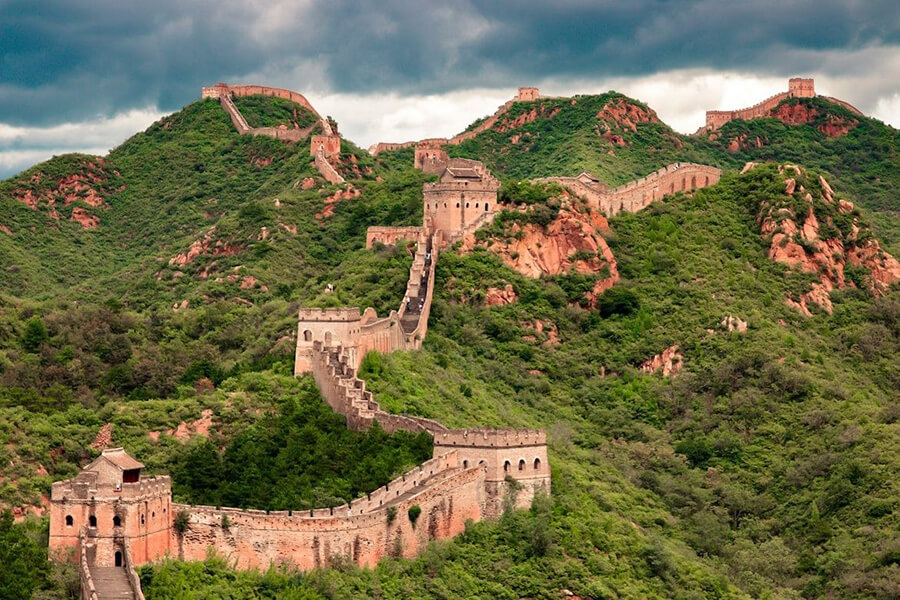China stands as a beacon in the realm of global tourism, captivating the imaginations of millions who embark on its storied landscapes each year. Within its borders lie a multitude of treasures, each a testament to the rich tapestry of human history and culture. Proudly adorned with the UNESCO World Cultural Heritage designation, China claims the illustrious second spot worldwide, boasting nearly 50 distinguished sites that weave a narrative of diversity and significance.
Among these revered locations are lofty structures perched upon majestic mountains, whispering tales of ancient civilizations and spiritual sanctuaries. In the heart of China’s wilderness, vast reserves stand as sanctuaries for the iconic giant panda, emblematic of the country’s commitment to biodiversity and conservation.
Wander through the cobbled streets of ancient cities, where time seems to have paused, preserving the architectural marvels and echoes of bygone eras. Each brick, each stone, tells a story that transcends centuries, a living testament to the resilience and creativity of generations past.
As we embark on this journey of discovery alongside VIMISS, the allure of China’s UNESCO World Cultural Heritage sites beckons—a mosaic of landscapes and narratives that stir the soul and spark the imagination. From the mist-shrouded peaks to the bamboo groves of panda reserves, and the timeworn stones of ancient cities, China’s cultural legacy unfolds, inviting us to explore the essence of its heritage.
The Great Wall
Erected amidst the ebb and flow of the Spring and Autumn Periods and the tumultuous Warring States Period, approximately during the 7th century BCE, the Great Wall of China stands as an unrivaled testament to human ingenuity and resilience. This colossal feat of construction spans a labyrinthine network across 15 provinces, encapsulating a saga of architectural brilliance and unwavering determination.
Embarking on a journey up the remnants of this ancient marvel, meandering through rugged mountainous landscapes, unveils more than just the impressive remnants of watchtowers and panoramic natural vistas. It becomes a profound encounter with the very essence of human achievement—a testament to the audacity and collective spirit that shaped this colossal historical monument.
Traversing the ruins of the Great Wall today offers not only a visual feast of awe-inspiring watchtowers and breathtaking landscapes but also a profound connection to the profound intelligence and indomitable spirit that etched this monumental chapter into the annals of history. Each stone, each brick, whispers tales of a civilization’s wisdom and courage, echoing through time as a living testament to the enduring legacy of the Chinese people.
Forbidden City
Nestled within the heart of Beijing, the Forbidden City, or Zǐjìnchéng in Chinese, emerges as a sprawling testament to imperial grandeur. This colossal palace complex, encompassing a vast expanse of 720,000 square meters, is more than a physical structure; it’s a living chronicle of China’s imperial history, spanning centuries of opulence and power.
Built during the dynamic epochs of the Spring and Autumn Periods and the Warring States Period, from 1406 to 1420, the Forbidden City comprises a staggering 980 buildings, a legendary number believed to house 9,999 rooms. This architectural marvel mirrors the intricate tapestry of traditional Chinese imperial design, echoing through time and space as a beacon of cultural influence across East Asia.
As you traverse the ancient stones of the Forbidden City, an aura of imperial legacy envelopes you. The sprawling complex, enclosed by lush royal gardens and fortified ramparts, is not merely a palace; it is an immersive journey into the heart of Chinese history. Explore the regal grounds, where the 54-acre Jingshan Park, the Temple of Heaven, the 171-acre Beihai Park, and the 57-acre Coal Hill Park stand as guardians to centuries of stories etched into the very stones beneath your feet.
Today, the Forbidden City is not merely a relic of the past; it is a vibrant hub of culture and history. The Palace Museum, which took charge in 1925, houses an extraordinary collection that once adorned the imperial quarters during the Ming and Qing dynasties. This repository of treasures, showcasing artworks and artifacts, bears witness to the artistic and cultural zenith of Chinese civilization.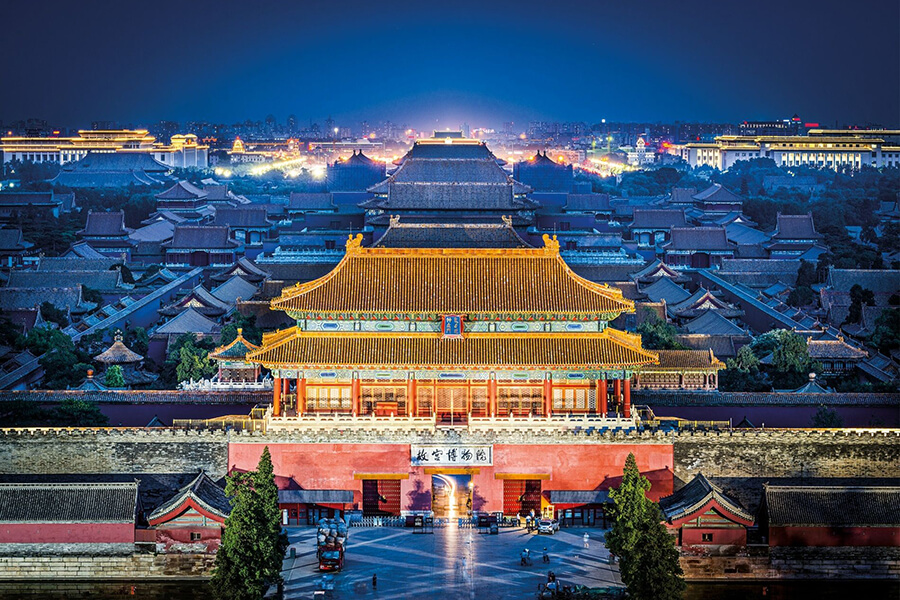
Stepping through the Forbidden City’s gates, you’re not just a visitor; you’re a time traveler, immersed in the intricate details of traditional Chinese architecture and the echoes of imperial footsteps that have resonated for over 500 years. With UNESCO’s nod to its cultural significance and a bustling annual footfall that exceeds 14 million, the Forbidden City remains a living testament to China’s imperial legacy, a destination where history breathes, and the whispers of emperors reverberate through its hallowed halls.
Mausoleum of the First Qin Emperor
Perched majestically atop the peaks of Mount Li in Lam Dong District, Tay An City, Thiem Tay Province, China, lies the awe-inspiring Mausoleum of Qin Shi Huang, also known as the Emperor Qin’s Tomb. This monumental marvel, a testament to architectural prowess, unfolded over an illustrious 38-year span, spanning the years 246-208 BCE. Cradled beneath the soaring heights of a 76-meter hill, the mausoleum assumes a distinctive pyramid-like silhouette, casting an enigmatic aura over the landscape.
The intricate design of the tomb meticulously mirrors the ancient Qin Dynasty’s capital, Xianyang. Within its precincts, inner and outer city zones unfold, with the inner city boasting a compact circumference of 2.5 km, while the outer city sprawls expansively across 6.3 km. Positioned in the southwestern embrace of the inner city, the main tomb reverently faces the east, each facet of its orientation laden with historical symbolism. At the core of this architectural marvel lies the central chamber, an ethereal sanctum enfolding the emperor’s hallowed coffin and an array of invaluable burial artifacts, resonating as the pulsating heart of this monumental sepulcher.
While the tomb awaits full excavation, the ongoing archaeological odyssey directs its focus to unraveling the mysteries veiled within the expansive cemetery’s bounds. Particularly captivating is the attention lavished upon the Terracotta Army, stationed to the east of the hill. These terracotta sentinels, poised as silent guardians of the tomb, stand frozen in time, their stoic demeanor preserving tales yet untold, anticipating the meticulous scrutiny of future archaeologists to unveil the nuances of their narrative.
Potala Palace
Perched like a celestial guardian on the undulating terrain of Lhasa, the capital of the Tibet Autonomous Region in China, the Potala Palace stands as a testament to centuries of spiritual and political significance. This majestic fortress, a dzong of unparalleled grandeur, once served as the winter retreat for the revered Dalai Lamas from 1649 to 1959. Its profound historical legacy has transcended time, transforming it into a museum and securing its place as a revered World Heritage Site since 1994.
Named after the mythical abode of the bodhisattva Avalokiteśvara, Mount Potalaka, the palace’s origins trace back to the visionary foresight of the 5th Dalai Lama in 1645. Guided by spiritual counsel from Konchog Chophel, who recognized its strategic location nestled between Drepung and Sera monasteries and the ancient city of Lhasa, the construction commenced. Some conjecture suggests that the palace might overlay the remnants of an earlier fortress, the White or Red Palace, commissioned by Songtsen Gampo in the year 637.
The architectural magnificence unfolds across 400 meters from east to west and 350 meters from north to south. Its formidable stone walls, gently sloping and averaging 3 meters in thickness (reaching 5 meters at the base), stand as silent sentinels against the elements, fortified with copper-laden foundations to withstand the tremors of the earth. Towering above Marpo Ri, the “Red Hill,” the palace’s thirteen soaring storeys host a symphony of over 1,000 rooms, 10,000 shrines, and approximately 200,000 statues, gracefully reaching a height of 117 meters. In total, the structure ascends more than 300 meters above the valley floor, creating an awe-inspiring panorama against the Tibetan sky.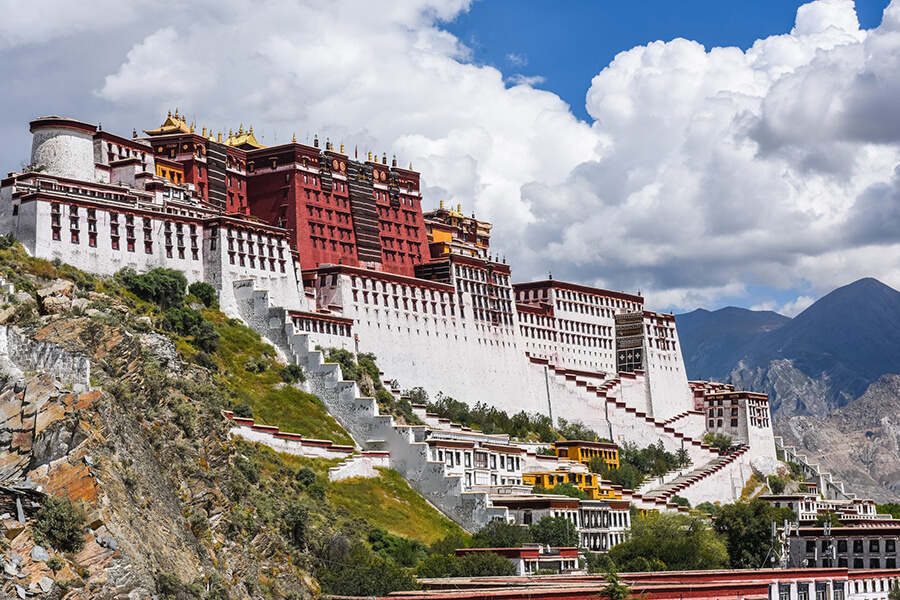
Legend intertwines with landscape as tradition holds that the trio of hills surrounding Lhasa embodies the “Three Protectors of Tibet.” Chokpori to the south, the soul-mountain of Vajrapani, Pongwari embodying Manjusri, and the pinnacle of spiritual grace, Marpori, the very hill upon which the Potala Palace majestically stands, symbolizing the divine presence of Avalokiteśvara. Each stone, each carving, resonates with the spiritual echoes of centuries, making the Potala Palace not merely a structure but a living testament to the soul of Tibet.
Mogao Caves
Nestled like a sacred sanctuary in the heart of Gansu province, China, the Mogao Caves, also known as the Thousand Buddha Grottoes or Caves of the Thousand Buddhas, stand as a testament to the rich tapestry of history woven along the Silk Road. Situated 25 kilometers southeast of Dunhuang, an oasis that thrived as a religious and cultural crossroads, these 500 temples form an ethereal landscape of spiritual and artistic marvels.
Dating back to 366 CE, the first caves emerged from the earth, conceived as havens for Buddhist meditation and worship. Over the centuries, the site evolved into a revered pilgrimage destination, with new caves continuing to be hewn into the cliffs until the 14th century. The Mogao Caves, alongside the Longmen Grottoes and Yungang Grottoes, stand as one of China’s three iconic ancient Buddhist sculptural sites, each narrating a profound tale of devotion and artistic brilliance.
Spanning a millennium, the Mogao Caves cradle within their walls some of the most exquisite examples of Buddhist art. From intricately carved statues to vibrant murals that whisper tales of bygone eras, the caves unfold a visual symphony that transcends time. Each cavern, a sanctum of spirituality, unveils a unique chapter in the evolution of Chinese Buddhist artistry.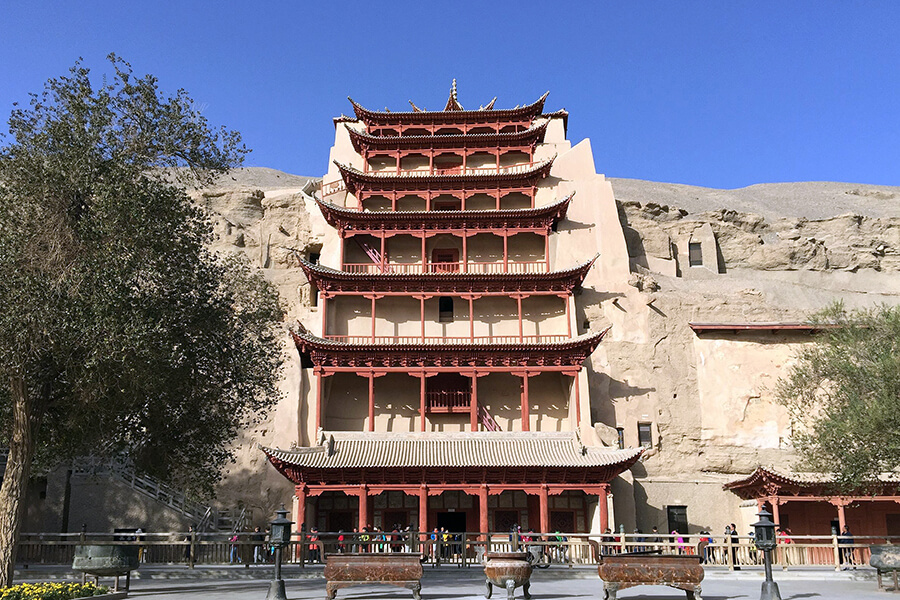
In the year 1900, a revelation unfolded within the enigmatic “Library Cave,” sealed since the 11th century. This hidden trove revealed a cache of precious documents that once illuminated the minds of ancient scholars. Today, remnants of this literary treasure are scattered across Beijing, London, Paris, and Berlin, safeguarded by institutions dedicated to preserving the wisdom encapsulated within the manuscripts.
As sunlight bathes the ancient rock, the Mogao Caves beckon modern pilgrims and curious travelers alike. While the caves have embraced their role as a popular tourist destination, a mindful cap on the number of visitors ensures a delicate balance between exploration and preservation. The Mogao Caves endure as guardians of time, inviting those who venture into their depths to witness the harmonious convergence of spirituality and artistic brilliance along the storied Silk Road.
Huangshan
In the heart of southern Anhui Province, where the whispers of legend and nature intertwine, unfolds the majestic panorama of Huangshan, a realm originally known as “Yishan.” Here, the very fabric of the mountains is woven with the threads of mythology, as it is said that Emperor Xuanyuan once pursued the elusive elixir of alchemy amidst these celestial peaks.
Huangshan, translating to the Yellow Mountain(s), stands as a testament to the artistry of nature, where the thickest tapestry of vegetation blankets the land below 1,100 meters, giving rise to a symphony of life. Trees ascend the slopes with unwavering determination, reaching towards the heavens until they touch the treeline at 1,800 meters, where the air is crisp with the promise of higher realms.
This sacred domain is renowned far and wide for its enchanting scenery, where sunsets paint the skies in hues beyond imagination. Peculiarly-shaped granite peaks stand as silent sentinels, each one a sculpted masterpiece crafted by the hands of time. Amidst this awe-inspiring landscape, Huangshan pine trees dance to the rhythm of the mountain breeze, their twisted forms echoing the tales whispered by ancient winds.
Huangshan is more than a geographical wonder; it is a sanctuary of hot springs, a canvas for winter’s artistic brushstrokes in the form of glistening snow, and a stage where clouds perform a celestial ballet visible from the mountain’s zenith. This ethereal realm has long been a muse for traditional Chinese paintings and literature, a timeless source of inspiration that continues to captivate the hearts of modern photographers.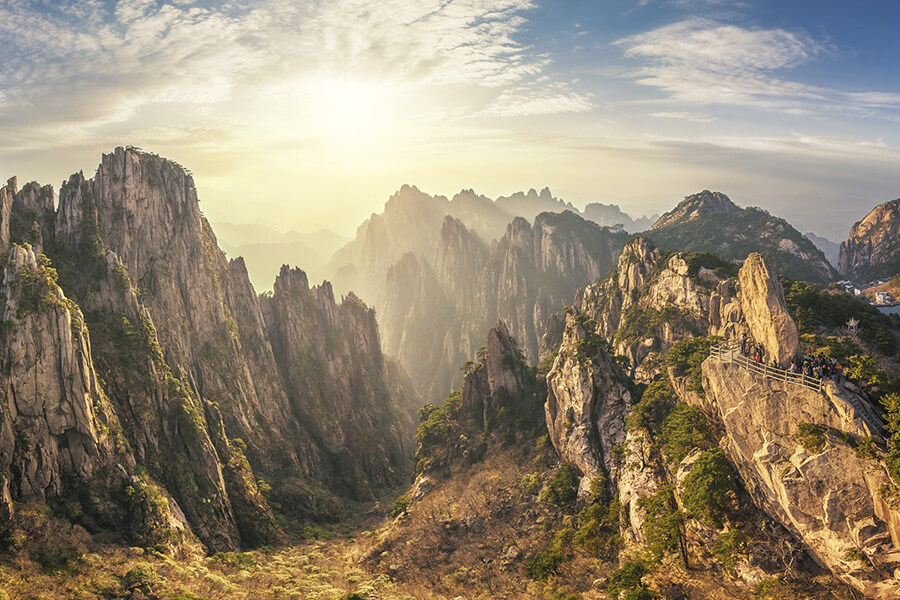
Recognized by UNESCO as a World Heritage Site, Huangshan beckons travelers on a pilgrimage to witness the harmonious convergence of myth and nature. It stands not only as a geographic marvel but as a cultural treasure, a testament to China’s profound connection with its natural wonders. Huangshan, a destination that transcends time, invites all who venture into its embrace to partake in a journey where the mundane meets the extraordinary, and the earthly touches the divine.
Leshan Giant Buddha
Rising majestically from the rugged embrace of Cretaceous red bed sandstones, the Leshan Giant Buddha stands as an awe-inspiring testament to ancient artistry and spiritual reverence. This monumental stone colossus, a grandeur of 71 meters, meticulously carved between 713 and 803 during the Tang dynasty, holds court at the confluence of the Min River and Dadu River in the southern reaches of Sichuan Province, near the city of Leshan.
Nestled against a natural canvas, the colossal Buddha gazes serenely towards Mount Emei, as if sharing a silent dialogue with the heavens. The Min and Dadu Rivers, faithful companions, flow beneath its giant feet, etching their own stories into the landscape. The stone marvel, an extraordinary fusion of human ingenuity and nature’s canvas, transcends time and stands as the largest and tallest stone Buddha in the world.
Fourteen centuries have passed since the first chisel marks were made, and yet, the Leshan Giant Buddha retains its pre-modern eminence, towering over the realms below. A harmonious dance of art and geography, it reclines over 4 kilometers from the sacred grounds of the Wuyou Temple.
Inscribed in the annals of UNESCO’s World Heritage Sites since 1996, the Mount Emei Scenic Area, embracing the Leshan Giant Buddha, invites modern wanderers to traverse time and stand in the shadow of a stone giant sculpted by ancient hands. It is not merely a statue but a spiritual sentinel, a guardian of tales untold, and a silent witness to the eons that have passed beneath its watchful gaze.
Old Town of Lijiang
In the heart of time, where history whispers through the cobbled streets, Lijiang emerges as a living testament to a millennium of stories. More than a town, it’s a chronicle etched into the fabric of the “Old Tea Horse Caravan Trail,” where the echoes of trade resonate from bygone eras. Dayan Old Town, with roots reaching back over a millennium, unfolds its ancient charm, inviting wanderers to trace the steps of merchants and explorers.
A labyrinth of orderly waterways and bridges weaves through the town, a testament to its once vibrant trade life. However, the intricate system, a dance of liquid veins, faces the subtle threat of time as the underground water table recedes, perhaps a consequence of modernity encroaching on suburban landscapes.
Steeped in the rich tapestry of Nakhi culture, Lijiang unfolds a harmonious blend of tradition and influences absorbed from Ming dynasty Han Chinese traders. Here, Nakhi people preserve a housing style learned from Nanjing traders, building timber and mud brick homes that stand as living artifacts of architectural mastery. Local carpenters, devoid of blueprints, craft intricate timber frames adorned with delicate flower and bird carvings, reminiscent of traditional Han Chinese aesthetics.
Music, a timeless companion, flows through Lijiang’s veins, a gift passed down from Ming Dynasty visitors. The old tunes find a home in Dayan Old Town, where local musicians, like guardians of a fading melody, perform regularly. The heartbeat of Lijiang pulses through circle dances, an ancient tradition led by Hakhi women in Nakhi costumes, resonating with vitality in the streets.
As you traverse the old town, vibrant circle dances unfold on street corners, a living mosaic of Nakhi, Tibetan, and Bai cultures. While Dayan Old Town breathes with Nakhi spirit, traces of Tibetan and Bai settlements linger in the cultural echoes. Even as the Tibetan and Bai communities find new homes beyond the tourist’s gaze, the rhythm of their circle dances finds sanctuary in the temple courtyards and festival grounds.
Lijiang, a cultural kaleidoscope, earned its place on the UNESCO World Heritage List, a recognition of its historical significance. Over two decades, the local government has embraced the dual responsibility of development and preservation, steering the town through the currents of time. Lijiang’s allure has drawn global travelers, but the Old Town’s redevelopment, tailored for the eyes of Han Chinese tourists, raises questions about the delicate balance between commercial appeal and the preservation of antiquity. Amidst this dance of progress, the essence of Lijiang, eternally intertwined with its past, continues to beckon explorers to unravel its tales and secrets.
Yinxu
In the cradle of ancient China’s enigmatic past lies Yinxu, a hallowed ground that whispers the secrets of a bygone era. Echoing with the footprints of history, it stands as the silent custodian of monumental revelations—the birthplace of oracle bones and the mysterious oracle bone script, a key to unraveling the earliest threads of Chinese writing.
Yinxu, also known as the ‘Ruins of Yin,’ emerges as the archaeological tapestry that cradled the last capital of China’s Shang dynasty. A dynasty that breathed life into eight generations spanning an awe-inspiring 255 years, ruled by 12 kings who etched their legacies into the annals of time. The tale of Yinxu began its renaissance in 1899 when its remnants, long veiled in obscurity, emerged into the light, a rediscovery that opened a portal to China’s ancient soul.
Today, Yinxu stands as a testament to the tenacity of time, a colossal archaeological site nestled in the northernmost reaches of Henan province. Here, in proximity to the modern city of Anyang, at the crossroads of Hebei and Shanxi, Yinxu beckons the curious to traverse the temporal bridge. Designated as a UNESCO World Heritage Site in 2006, it unfolds as one of China’s most venerable and expansive archaeological legacies.
As you step into Yinxu, the air crackles with the energy of millennia past. Ancient remnants breathe life into the stones, each bearing witness to the rise and fall of dynasties. The gates of Yinxu swing open, inviting contemporary souls to touch the whispers of an era steeped in mystery.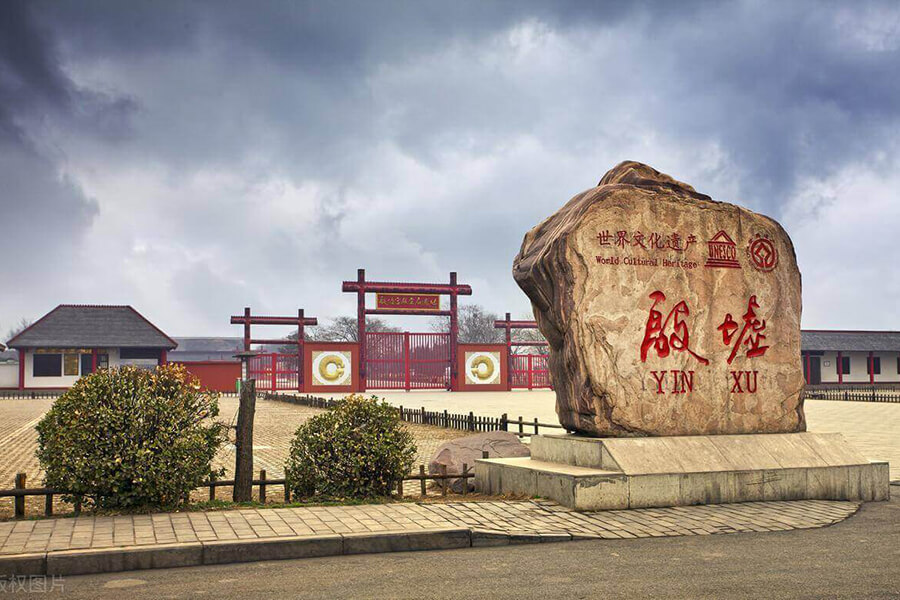
Wandering through Yinxu, the interplay of shadows and sunlight reveals fragments of grandeur—a once-thriving metropolis that has weathered the eons. Amidst the timeworn stones, the stones that cradled palaces and witnessed the ebb and flow of imperial reigns, visitors stand on the threshold of a rich historical trove.
Yinxu stands as a conduit between the past and the present, an open invitation for those who seek to commune with antiquity. Here, public access isn’t just permitted; it is an embrace—a chance to walk in the footsteps of ancient kings and grasp the essence of China’s enigmatic roots. As the sun sets over Yinxu, casting shadows that dance with the spirits of bygone rulers, the ancient capital unfolds its secrets to those who pause to listen.
Mount Wutai
Nestled at the serene headwaters of the Qingshui River in Shanxi Province, China, Mount Wutai emerges as a sacred tapestry, woven with the threads of Buddhist spirituality and natural grandeur. Known by its poetic moniker Wutaishan, or Mount Qingliang, it stands as a beacon of divine tranquility.
The heart of Mount Wutai unfolds as a sacred mandala, cradled by a ring of flat-topped peaks, akin to celestial sentinels guarding the cardinal directions. Among this ethereal congregation, the north peak, Beitai Ding or Yedou Feng, ascends majestically as the zenith, reaching a celestial altitude of 3,061 meters (10,043 feet) above the sea. It proudly claims the title of the loftiest summit in North China.
This hallowed mountain is not merely a geological masterpiece; it is a sanctuary adorned with over 53 sacred monasteries, each a testament to the spiritual resonance that permeates the air. Within the folds of Mount Wutai, China’s spiritual heritage finds expression in some of the nation’s most venerable monasteries and temples. A sacred chorus of prayer and wisdom echoes through the valleys, harmonizing with the rustle of leaves in the mountain breeze.
In recognition of its profound cultural and spiritual significance, Mount Wutai earned its place among UNESCO’s World Heritage Sites in 2009. As the golden sun casts its benevolent glow upon the peaks, visitors are transported to a realm where the earthly and the divine dance in graceful unity.
Mount Wutai isn’t merely a pilgrimage for the soul; it’s a visual symphony, a feast for the senses. Each step unveils a tapestry of natural wonders and architectural marvels, where ancient monastic structures blend seamlessly with the verdant landscape. The mountain’s sacred energy weaves through the air, inviting contemplation and connection with something greater than oneself.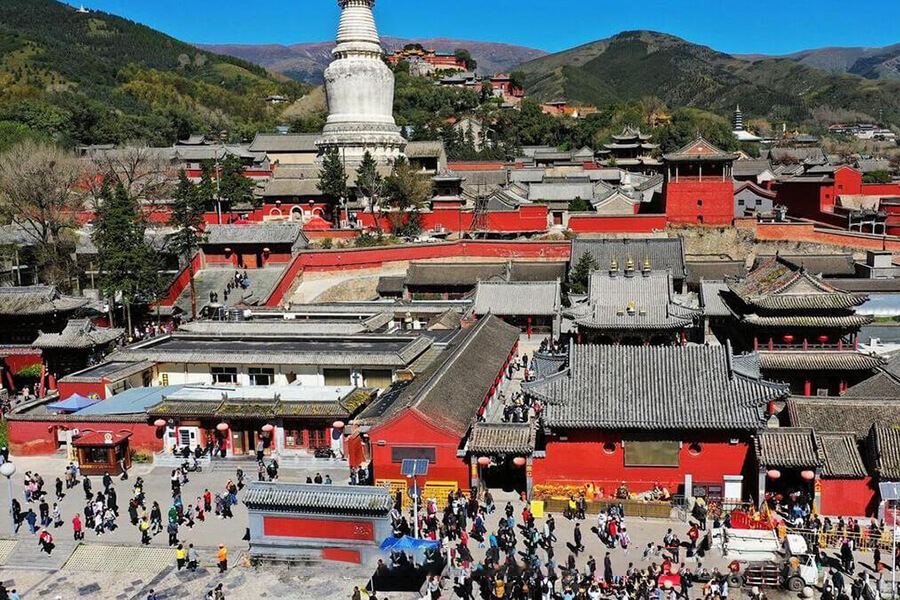
Acknowledging its allure and significance, China’s National Tourism Administration bestowed upon Mount Wutai the prestigious AAAAA status in 2007. As travelers embark on a pilgrimage to this hallowed peak, they enter a realm where the whispers of the wind carry ancient prayers, and the towering summits stand as testament to the enduring dance between the sacred and the earthly.

